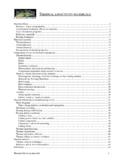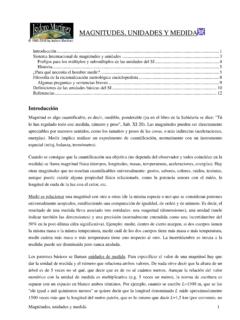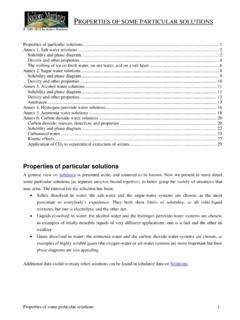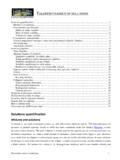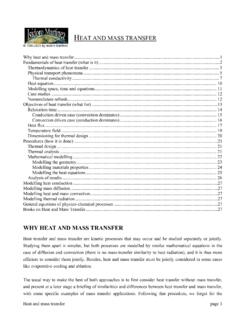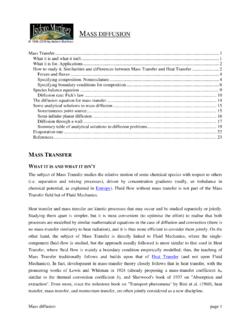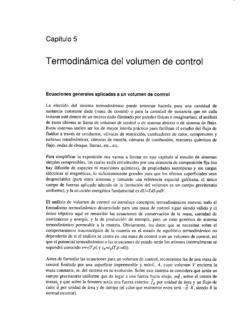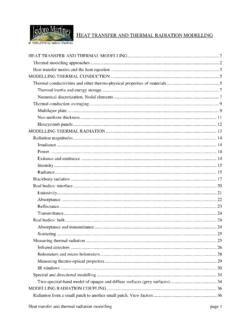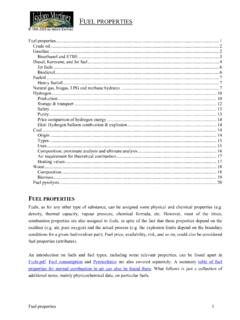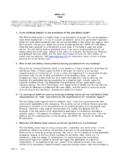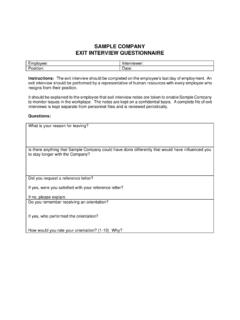Transcription of NOZZLES - UPM
1 NOZZLES 1 NOZZLES NOZZLES .. 1 nozzle flow equations .. 4 Choked flow .. 5 Area 6 Converging nozzle .. 7 Converging-diverging nozzle .. 9 Discontinuities in nozzle flow: normal and oblique shocks, expansion fans. Mach diamonds .. 14 Aerospike nozzle .. 18 NOZZLES A nozzle (from nose, meaning 'small spout') is a tube of varying cross-sectional area (usually axisymmetric) aiming at increasing the speed of an outflow, and controlling its direction and shape. nozzle flow always generates forces associated to the change in flow momentum, as we can feel by hand-holding a hose and opening the tap.
2 In the simplest case of a rocket nozzle , relative motion is created by ejecting mass from a chamber backwards through the nozzle , with the reaction forces acting mainly on the opposite chamber wall, with a small contribution from nozzle walls. As important as the propeller is to shaft-engine propulsions, so it is the nozzle to jet propulsion, since it is in the nozzle that thermal energy (or any other kind of high-pressure energy source) transforms into kinetic energy of the exhaust, and its associated linear momentum producing thrust.
3 The flow in a nozzle is very rapid (and thus adiabatic to a first approximation), and with very little frictional loses (because the flow is nearly one-dimensional, with a favourable pressure gradient except if shock waves form, and NOZZLES are relatively short), so that the isentropic model all along the nozzle is good enough for preliminary design. The nozzle is said to begin where the chamber diameter begins to decrease (by the way, we assume the nozzle is axisymmetric, with circular cross-sections, in spite that rectangular cross-sections, said two-dimensional NOZZLES , are sometimes used, particularly for their ease of directionability).
4 The meridian nozzle shape is irrelevant with the 1D isentropic model; the flow is only dependent on cross-section area ratios. Real nozzle flow departs from ideal (isentropic) flow on two aspects: Non-adiabatic effects. There is a kind of heat addition by non-equilibrium radical-species recombination, and a heat removal by cooling the walls to keep the strength of materials in long-duration rockets ( operating temperature of cryogenic SR-25 rockets used in Space Shuttle is 3250 K, above steel vaporization temperature of 3100 K, not just melting, at 1700 K).
5 Short-duration rockets ( solid rockets) are not actively cooled but rely on ablation; however, the nozzle -throat diameter cannot let widen too much, and reinforced materials ( carbon, silica) are used in the throat region. NOZZLES 2 There is viscous dissipation within the boundary layer, and erosion of the walls, what can be critical if the erosion widens the throat cross-section, greatly reducing exit -area ratio and consequently thrust. Axial exit speed is lower than calculated with the one-dimensional exit speed, when radial outflow is accounted for.
6 We do not consider too small NOZZLES , say with chamber size <10 mm and neck size <1 mm, where the effect of boundary layers become predominant. Restricting the analysis to isentropic flows, the minimum set of input parameters to define the propulsive properties of a nozzle (the thrust is the mass-flow-rate times the exit speed, eFmv= ) are: nozzle size, given by the exit area, Ae; the actual area law, provided the entry area is large enough that the entry speed can be neglected, only modifies the flow inside the nozzle , but not the exit conditions .
7 Type of gas, defined with two independent properties for a perfect-gas model, that we take as the thermal capacity ratio cp/cv, and the gas constant, R Ru/M, and with Ru= J/(mol K) and M being the molar mass, which we avoid using, to reserve the symbol M for the Mach number. If cp is given instead of , then we compute it from cp/cv=cp/(cp R), having used Mayer's relation, cp cv=R. Chamber (or entry) conditions : pc and Tc (a relatively large chamber cross-section, and negligible speed, is assumed at the nozzle entry: Ac , Mc 0).
8 Instead of subscript 'c' for chamber conditions , we will use 't' for total values because the energy conservation implies that total temperature is invariant along the nozzle flow, and the non-dissipative assumption implies that total pressure is also invariant, Tt=Tc and pt=pc. Discharge conditions : p0, the environmental pressure (or back pressure), is the only variable of importance (because pressure waves propagate at the local speed of sound and quickly tend to force mechanical equilibrium, whereas the environmental temperature T0 propagates by much slower heat-transfer physical mechanisms).
9 Do not confuse discharge pressure, p0, with exit pressure, pe, explained below. The objective is to find the flow conditions at the exit [pe,Te,ve] for a given set of the above parameters, [Ae, ,R ,p c,Tc,,p0], so that: eeeeeeeeeee,,pvmvAvAF mvMRTRT ==== (1) If the nozzle flow is subsonic, then the exit pressure coincides with the discharge pressure, pe=p0, at the steady state (if at an initial state they were not equal, the time it would take to equalise is of the order of the nozzle length divided by the sound speed), and the other variables would be obtained from the isentropic relations.
10 NOZZLES 3 122ee0eeee1,1122ttppT vppMpTcT ===+=+ (2) Converging NOZZLES are used to accelerate the fluid in subsonic gas streams (and in liquid jets), since at low speeds density do not vary too much, and constmvA = = can be approximated by vA=const. Liquid jets and low speed gas flows can be studied with classical Bernoulli equation (until cavitation effects appear in liquid flows), but high-speed gas dynamics is dominated by compressibility effects in the liquid. By the way, we do not considered here multiphase flow in NOZZLES .
